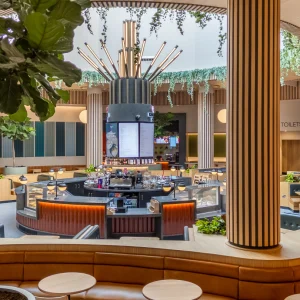
After spending many years of his childhood playing with LEGO, Duncan Titmarsh’s job today sees him building LEGO ‘models’ for some of the most prestigious public spaces. As one of only 12 LEGO Certified Professionals in the world – and the only one in the UK – Titmarsh’s business Bright Bricks is quite literally built from a lifetime’s passion.
With a workshop and office in Bordon, Hampshire, business has been developing well for him over the past five years since officially becoming a full-time LEGO worker.
‘I have a nice large log cabin in my garden, which used to be my office when I first started out building models professionally. It’s now the largest shed I’ve ever had!’ he declares. Titmarsh recalls first being in demand in 2003, after his local BBC radio station invited him to build live in the studio. ‘Yeah, I’ll do that,’ was his casual response. ‘I went along with some bricks and three hours later had a little model done. After that people started to ring me up asking for models, and from there it sort of grew.’
Titmarsh was joined by his business partner Ed Diment in early 2011, and together they manage a team of builders and key administrative staff. ‘The team is very diverse in skills and Ed is very technical in his approach, whereas I just like to build big stuff,’ says Titmarsh. Yet despite what sounds to some like a ‘dream job’ – an all too familiar comment made to Titmarsh – he is also quick to point out his ever-increasing business commitments: ‘It is the best job in the world, but it is hard work. Fun, but hard work. Obviously you’ve still got to manage a business and projects must go out on time.’
One of Bright Bricks’ recent commissions was for Transport for London, as part of the Underground’s 150th anniversary, to build five Tube maps each detailing different stages of the system’s development. With each LEGO map made from more than 1,000 bricks and taking four days to build, contrary to what many may think the planning of model building does not usually require a technical drawing.
As with most of Bright Bricks’ models, Titmarsh and the team are happy to approach each project with the use of ‘free building’. ‘Typically we would scale up what is needed to build, do a quick sketch with some dimensions, build some LEGO studs – and then just build,’ he explains.
Titmarsh does say that some projects require a little more preparation work, especially when dealing with much larger models – such as the 12.2m-tall LEGO Christmas tree at St Pancras Station in 2011. The model broke the world record for the largest LEGO Christmas tree, comprising approximately 400,000 bricks and weighing in at more than three tonnes.
The need for a steel frame and an engineer were most certainly required for such a large structure, with the branches pre-built off site and the trunk constructed on site. And a cherry picker was needed to assemble the tree, which took a total of two weeks to build.
Bigger than the St Pancras Christmas tree was the 2012 Christmas advent calendar, installed in Covent Garden. Built with approximately 700,000 bricks, it was delivered to site in four sections and lifted straight off the lorry to put in situ. ‘Some jobs may take all night and some jobs are literally pull up the van, take off, put down and the job’s done. They are all unique pieces, so every model is different,’ says Titmash.
This year’s Christmas project saw Titmarsh and his team returning to Covent Garden to install their latest model. Unveiled last month, a giant LEGO snow globe – featuring a snowy London scene and models of 14 iconic buildings including The Shard, Big Ben and Nelson’s Column – is on show. Using some 120,000 LEGO bricks, and taking 75 days to build, the tallest building (needless to say The Shard) measures more than 2m in height.
With jobs so varied and clients requesting that projects remain top secret until the grand unveiling, the majority of Titmash’s clients are to be found in the corporate sector. Live builds during trade shows and for product launches are a particular favourite with both companies and audience, many whom will return to the stand during the shows to see the progress of models as they are built.
With businesses realising the easy, familiar interaction people have with LEGO models, resulting in them being a useful promotional tool, Titmarsh has found business is ever increasing. As an example this, Titmarsh recalls: ‘We were commissioned by Rolls- Royce to make a model of a jet engine, for the Farnborough Air Show, and it was amazed at just how much attention it attracted. So much so, it has commissioned us to do another one.’
He puts this down to the individual’s relationship with LEGO and the familiarity it has with the public. ‘People don’t tend to know how a jet engine works, so the cut-away model of the engine details what bit does what in a language that people are more familiar with. It’s something you can’t do with a real jet engine.’
As it happens though, Titmarsh may have a better understanding of the workings of an engine than most. Before becoming a professional LEGO builder he worked at the Honda factory in Swindon – building engines. Other previous jobs added to his building knowledge too – he also worked as a kitchen and bathroom fitter. But now, with his future looking as firmly anchored as a LEGO brick on its plinth, he has bigger ambitions.
‘I’d like to take the time to expand an architectural range,’ he says. ‘We were discussing whether of not it is possible to actually build a house out of LEGO.’ Titmarsh reckons it can be done.
And while he is keen to keep pushing his business into unexplored markets, Titmarsh is also set on satisfying some other personal aims too: ‘I’d like to build a full-sized London bus. Why? Because it’s never been done. After doing the Tube maps I’d like to try some more 2D artwork and pictures. I enjoyed doing that as well, so there are lots of avenues to explore. We’ve just got to find the time to do it!’






